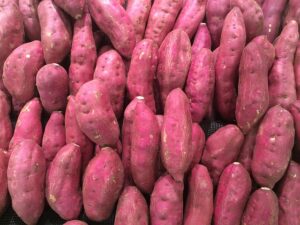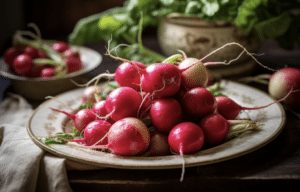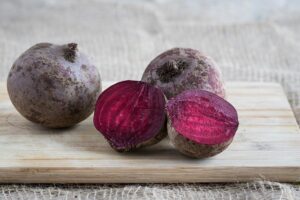Introduction – Pink Veggies And Nutritional Punch
Vegetables in place of meat are an excellent way to cut carbon emissions because of the immense carbon burden of raising meat as food sources. That means being able to leverage diverse enough vegetable sources to get sufficient nutrient content.

Ensuring diverse vegetable sources sounds vague. There’s actually a way to quantify it, using the concept of phytonutrients. The word phytonutrient comes from the word “phyto,” meaning plant. Phytonutrients are natural substances found in plant foods, it gives them their colors and are a key reason why we are encouraged to eat a variety of fruits and vegetables, of many different colors, every day.
Phytonutrients are involved in many important functions in the body, including detoxification, cellular repair, hormone and neurotransmitter production, and inflammation reduction. There are more than 25,000 phytonutrients in the plant world. Common classes of phytonutrients include carotenoids, flavonoids, phenolic acids, isothiocyanates.
Ten Vegetables With A Pink Hue
We put a table of our ten veggies right here. Each vegetable choice is carefully explained in the paragraphs that follow.
| Vegetable | Distinctive Features |
|---|---|
| Beets | Nutritionally rich, especially in nitrates that can boost circulation and athletic performance. |
| Radishes | High in fiber, vitamin C, and other antioxidants, offering a spicy crunch when added to meals. |
| Rainbow Carrots | Rich in beta carotene which supports healthy skin, cell growth, and eyesight. |
| Pink Turnips | Provide an abundance of potassium, folate, and vitamin B6 |
| Cassava | A starchy root vegetable rich in fiber and vitamin C |
| Pink Potatoes | Also known as “Peruvian Purple” potatoes; loaded with minerals and vitamins |
| Pink Bell Peppers | Rich in nutrients like vitamin C and carotenoids, and offer a mild, sweet flavor. |
| Chives | Nutritionally dense, offering a wide range of vitamins and minerals. |
| Pink Kale | Considered highly nutrient-dense, rich in fiber, calcium, vitamins, and minerals, particularly anthocyanins. |
| Pomegranates | Antioxidant-rich, high in fiber and low in calories, offering a sweet taste. |
10 Pink Veggies To Try
Here are the 10 veggies from the table above.
1. Beets
Beets are packed with vitamins and minerals, including nitrates, improving circulation and athletic performance. Roasting beets brings out their sweetness while maintaining their nutritional value, or you can enjoy them raw by shredding them into a colorful slaw.
Whatever way you choose to incorporate these pink powerhouses into your diet, your body will thank you for it. Don’t forget to save the greens – they’re also jam-packed with nutrients!
2. Radishes

Radishes are high in fiber, vitamin C, and other antioxidants that promote healthy digestion and immune function. When sliced or diced raw, they add a spicy crunch to sandwiches, tacos, and salads. They help keep your digestive system running smoothly, and these little pink veggies can also provide important defenses against disease.
Add vibrant pink radishes to your next meal for flavor and health benefits. And for a delicious twist on a classic dish, try grilling radishes for a smoky addition to any summer cookout.
3. Rainbow Carrots
Carrots come in various colors – red, orange, yellow, and even purple and white. However, have you ever tried rainbow carrots? These vibrant pink veggies are not unique and pretty to look at, but they are also packed with beta carotene, an antioxidant that supports healthy skin, cell growth, and eyesight.
Why not switch things up next time you’re at the grocery store and grab a bunch of pink carrots instead? Roast them in the oven with olive oil and spices for a nutrient-rich side dish, or add them to your favorite stir fry for a pop of color. They can be enjoyed raw or cooked, making them a versatile addition to just about any dish.
4. Pink Turnips
One pink veggie that is often overlooked is the pink turnip. These root vegetables might not be as popular as their white counterparts, but they pack an impressive nutritional punch.
Just one pink turnip provides a hefty dose of potassium, folate, and vitamin B6 – important nutrients for heart health, brain function, and cell growth. Plus, pink turnips have a mild, slightly sweet flavor that pairs well with other vegetables or salads.
5. Cassava
Also known as yucca or manioc, cassava is a starchy root vegetable rich in fiber, and vitamin C. Cassava is native to South America. It can be found in several forms, including deep purple roots, crunchy chips, or flour.
Whether you’re snacking on cassava chips as a healthy alternative to traditional potato chips or adding them to casseroles for some added nutrition, these versatile pink veggies will not disappoint. It can be used in bread and desserts for its chewy texture and sweet flavor or added to soups and stews for added nutrition.
6. Pink Potatoes
Pink potatoes, sometimes referred to as “Peruvian Purple” potatoes, are a beautiful and nutritious addition to any meal. Not only do they add visual interest to your plate with their pinkish-purple skin and flesh, but they also pack a powerful nutrient punch.
These pink veggies are a great source of minerals such as potassium, phosphorus, and magnesium. They also contain antioxidants like anthocyanins, which are linked to various health benefits. And if that wasn’t enough, pink potatoes also boast high levels of vitamin B6, essential for energy metabolism and brain function.
7. Pink Bell Peppers
While we often think of bell peppers as green, red, or yellow, pink varieties also exist and offer a mild flavor that makes them great for adding to salads and veggie platters. Pink bell peppers are just unripe versions of the red variety, meaning they have a slightly crunchier texture and sweeter taste.
These pink peppers pair well with other soft and crisp veggies in a salad or can be thinly sliced and added on top of sandwiches for a pop of color. Pink bell peppers are also rich in nutrients like vitamin C, making them a tasty and healthy addition to any meal.
They are also rich in carotenoids like beta-carotene and lutein, which aid vision health and may reduce the risk of certain cancers.
8. Chives
Incorporate chives and their pink flowers into your meals for a pop of color and important vitamins and minerals. The greens and flowers pack a nutritional punch, providing vitamin C, potassium, iron, copper, calcium, phosphorus, magnesium, zinc, sodium, folic acid, and vitamins A & K1.
Use them as a garnish on salads or soups for added texture and flavor. Or mix them into scrambled eggs for added nutrition in the morning. These pink veggies are not only visually delightful but also packed with nutrients crucial for maintaining overall health.

9. Pink Kale
This is just one of the many nutrient-packed color variants of the leafy green. Pink kale is considered one of the most nutrient-dense vegetables out there. It has high fiber, calcium, vitamins A and C, iron, potassium, and folate levels.
And it’s not just pink kale that packs a punch – other pink veggies like radishes and carrots also have higher levels of nutrients than their more commonly-seen counterparts. Its vibrant pink variety is rich in anthocyanins which may help prevent heart disease and certain cancers.
10. Pomegranates
Pomegranates may be small and pink, but they pack a punch regarding nutrition. These tasty fruits contain antioxidants like vitamin C and polyphenols to protect cells from damage. What’s more, they’re also high in fiber and low in calories, making them a great addition to any diet.
But why stop at just eating the seeds? Pomegranate juice and even pomegranate molasses can add unique flavor to dishes while providing the same health benefits. Their juicy seeds can be eaten raw or sprinkled over oatmeal or smoothies for a sweet burst of flavor.
Color And Phytonutrient Nutrition
Some of the nutrients that make vegetables red or pink include lycopene, anthocyanins, and betalains. Lycopene is a carotenoid that gives tomatoes, watermelons, and pink grapefruits their red color. Anthocyanins are found in red cabbage, red onion, and red peppers. Betalains are found in red beets, red Swiss chard, and red spinach.
Lycopene: Lycopene is a powerful antioxidant that has been linked to a reduced risk of cancer, heart disease, and other chronic diseases. It also has anti-inflammatory properties and may improve skin health.
Anthocyanins: Anthocyanins are powerful antioxidants that may help reduce inflammation, improve heart health, and protect against cancer. They also have antibacterial, antiviral, and antifungal properties.
Betalains: Betalains are powerful antioxidants that may reduce inflammation and improve heart health. They may also help protect against cancer and reduce the risk of diabetes.
But it’s not just their health benefits that make pink veggies stand out; they add visual interest to salads and veggie platters with their vibrant color. When added to salads or grain bowls, roasted beet slices offer an earthy sweetness, while pink radishes provide a sharp crunch as topping on sandwiches or tacos.
Pink carrots can be enjoyed raw or cooked- try spiralizing them into ribbons for a colorful twist on noodles or toss them in creamy pink sauces for pasta dishes. Don’t be afraid to get creative with pink veggies- they may surprise you with their versatility and delicious flavor.
Wrapping Up
In conclusion, many different types of pink vegetables offer a variety of nutritional benefits. Some popular pink veggies include sweet potatoes, pink potatoes, bell peppers, pink kale, and pomegranates.
You can add these delicious and nutritious foods to salads and soups to boost flavor and nutrients or eaten raw as snacks or garnishes. Whether you’re looking for a tasty way to add more antioxidants to your diet or simply want some vibrant color on your plate, these pink veggies have you covered!
